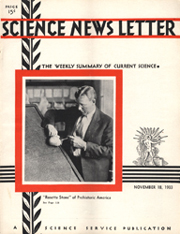From the November 18, 1933, issue

“ROSETTA STONE” OF PREHISTORIC AMERICA
Frank M. Setzler of the Smithsonian Institution is shown pointing to a little pottery bowl which he likens to the Rosetta Stone of the Nile because it is decorated with two kinds of art design, one known and the other unknown. Together with other discoveries made under Mr. Setzlers direction in mounds at Marksville, La., this bowl is expected to aid archaeologists in linking the shadowy Mound Builders with Indians of recent times. Mr. Setzler is leaning on a reproduction of the Rosetta Stone which enabled Egyptologists to read the hieroglyphics of Egypt. A complete report of this discovery was given in last weeks Science News Letter.
GLASSY STONES MAY BE FROM SHATTERED PLANETS
Tektites, peculiar glassy stones usually of a bottle-green color, found in various parts of the world, are probably fragments of some shattered planet, like the better-known meteorites, in the opinion of Dr. V.S. Dubey of Benares Hindu University, India. Scientists had disagreed as to the origin of these curious stones, some maintaining that they were formed by the action of lightning and others that they were due to meteorites causing the rocks which they hit to melt and take on a glassy appearance.
Dr. Dubey, in a communication to Nature, shows that the amount of radium present in tektites found in widely separated parts of the world is very nearly constant (about one ten-trillionth) and that they could not have derived this radium from ordinary meteorites, which do not contain as much radium.
“This strongly suggests, ” writes Dr. Dubey,” that these tektites are derived from some mass which agrees in chemical composition as well as in radioactivity with the granitic layer of the earth.”
Meteorites, which are definitely known to have fallen on the Earth from outer space, consist either of a mixture of iron and nickel, or of stony material which, unlike that of the tektites, is basic, that is, it contains less silica.